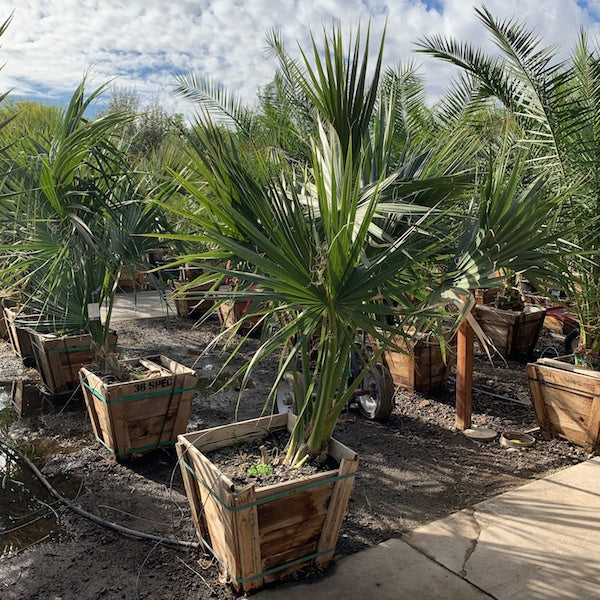My Store
Cabbage Palm
Cabbage Palm
Couldn't load pickup availability
Plant Type: tree
Plant Height: 40-50 feet
Spread: 10-15 feet
Flower Color:
Sun Exposure: Full Sun
Description:
The Cabbage Palm, scientifically known as Sabal palmetto, is a distinctive and hardy palm tree that can thrive in the Arizona landscape, particularly in regions with a milder climate or as a container plant. Although not native to Arizona, it is well-suited to the state's desert environment, provided it receives adequate care and protection during harsh weather conditions.
One of the standout features of the Cabbage Palm is its striking appearance. It features a single, stout trunk topped with a cluster of large, fan-shaped fronds. The fronds have a deep green color and can grow up to several feet in length, creating a lush and tropical aesthetic in the landscape.
The name "Cabbage Palm" comes from the heart of the palm, which is edible and has a flavor reminiscent of cabbage. However, harvesting the heart of the palm is not recommended as it can harm the tree and is regulated in some areas.
The Cabbage Palm typically reaches heights of 20 to 40 feet, making it a relatively tall palm tree. Its graceful form and canopy provide an excellent focal point in the garden and can also offer some shade in its immediate vicinity.
This palm tree is well-suited to Arizona's climate, particularly in regions with milder winters. It is drought-tolerant once established, making it suitable for water-wise landscaping. However, it benefits from regular watering during dry spells and protection from extreme cold temperatures, which can damage the fronds.
Maintenance of the Cabbage Palm is generally minimal. Regular pruning is typically not required unless it's to remove dead or damaged fronds. Additionally, providing well-drained soil and mulching around the base of the tree can help maintain its health.
In summary, the Cabbage Palm is an attractive and adaptable choice for Arizona landscapes, particularly in areas with a more moderate climate or when planted in containers. Its tropical appearance, low maintenance needs, and tolerance of drought make it a valuable addition to gardens and outdoor spaces, adding a touch of elegance and exoticism to the desert environment.
Three Timbers Installation Guide (Feel Free to Follow): Cabbage Palm
Planting Guide:
- Location: Full sun (at least 6 hours of direct sunlight daily for optimal growth)
- Soil: Well-drained, sandy or loamy soil (slightly acidic to neutral soil preferred)
- Spacing: Space plants 8-10 feet apart to allow for the tree's mature size and optimal air circulation
- Planting Depth: Plant at the same depth as the root ball, ensuring the top of the root ball is level with the surrounding soil surface. Avoid planting too deep to prevent root rot.
- Support: No staking is typically required unless the tree is young or experiencing high winds. Cabbage Palm grows upright with a thick trunk and a large crown of fan-shaped leaves.
Watering Guide:
Watering After Planting:
- Initial Watering: Water thoroughly immediately after planting to saturate the root ball and surrounding soil
- Frequency: Water every 2-3 days for the first 2-3 weeks to help establish the root system
- Watering Amount: Provide 1-2 inches of water per session, ensuring deep watering around the roots and allowing the soil to drain well
When is the Plant Established?
- Timeframe: Cabbage Palm is considered established after 6-8 months when the roots have spread into the surrounding soil and the tree begins showing consistent new growth
Watering Once Established:
- Summer: Water every 10-14 days during the hotter months. If temperatures exceed 100°F, increase watering to every 7-10 days. Provide 1.5-2 inches of water per session.
- Winter: Water every 3-4 weeks during the cooler months, depending on rainfall. Cabbage Palm is moderately drought-tolerant once established but benefits from occasional deep watering during dry winter periods.
Drip Irrigation Setup:
- Placement of Emitters: Place the drip emitters 18-24 inches away from the base of the tree to ensure water reaches the root zone and encourages deep root growth. Avoid wetting the trunk directly to prevent rot.
- Flow Rate: Use emitters with a flow rate of 2-4 gallons per hour for slow, deep watering. This ensures that water penetrates deeply into the soil and supports healthy root development.
- Number of Emitters: Place 2-3 emitters around the base of the tree to ensure even water distribution. Adjust the number of emitters as the tree matures.
- Irrigation Zone: Set up a dedicated irrigation zone for Cabbage Palm and other trees that require deep watering, allowing you to adjust the watering schedule based on the tree’s needs.
- Adjusting Frequency: In the summer, increase watering frequency to every 7-10 days to ensure the tree stays hydrated, especially during high heat. In winter, reduce watering to every 3-4 weeks or adjust based on rainfall.
General Watering Tips:
- Soil Check: Check the soil moisture regularly. Water when the top 2-3 inches of soil feel dry to the touch.
- Avoid Overwatering: Cabbage Palm prefers well-drained soil and does not like sitting in water. Overwatering can lead to root rot, so ensure that the soil drains well and avoid standing water around the base of the tree.
- Mulch: Apply a thin layer of mulch around the base to help retain moisture, keep the roots cool, and reduce weed growth. Avoid placing mulch directly against the tree’s trunk to prevent rot.
Share












